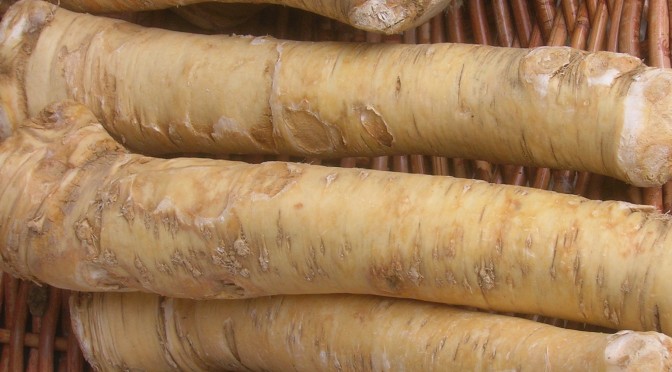No horsing around here; Horseradish has kick!
I admit that I am not a horseradish fan, not in any form. It does add hot flavor to dressings and I am fine with the spicy dipping sauce that many restaurants use with fried onions and jalapeno poppers, because they aren’t spicy enough on their own. But eat it with my prime rib? No, thanks! I know a lot of people do like it, PK being one of them. We usually have a jar of it in the ‘fridge and I generally ignore it, so don’t look for any great horseradish recipes on this site.
Having said that, here’s a little background information on this culinary hot flash. First off, horseradish is in the mustard family— now I’m very fond of mustard— but it is the less desirable cousin, in my opinion. That family line includes kale, cauliflower, Brussels sprouts, wasabi and other radishes. Horseradish is well-endowed with isothoicyanate, which when combined with air and saliva, produce the hot taste.
Going back to 1500 B.C., the Egyptians knew about it and used it, although it’s not clear if it was for eating or other purposes. The Greeks used it to treat lower back pain as well as an aphrodisiac. (How did that work?) The English name of horseradish may have come about because of a mispronunciation of the German name meerrettich, which means sea radish, and with the meer becoming mare, which in turn changed to horseradish. By the 1600’s, the horseradish had spread across Europe, Scandinavia and made it to England. The English grew it at their inns and coach stations in order to make a pungent cordial to revive weary travelers and to serve with dinner.
From England, the root made the inevitable journey to the Americas where the growing of it firmly took hold in the Northeast and it even grew wild around Boston. By the mid-19th century, farmers in the mid-west had begin cultivating it in the fertile soil near the Mississippi River in Illinois. This area is still a hotbed of horseradish production with Collinsville , Illinois holding an International Horseradish Festival annually.
Making the root into Horseradish Sauce
Once the root is harvested, it’s sold to manufacturers who have machines to grate the roots, which releases the oils that make it unique. Then the ground-up root is neutralized with vinegar and additional spices and other ingredients, such as sugar, cream or oil may be added. I do see horseradish roots in the produce department now and then, so it is possible to grate and make your own. Be warned though, this is worse than peeling onions. For more instructions on it, here’s a recipe from a horseradish-friendly site, Serious Eats.
Feeling Adventurous? Here’s a recipe from My Recipes.com for Peach Horseradish Maple Syrup. That actually doesn’t sound too bad. I may have to revise my view on horseradish a bit, although I’m sure you could make this with mustard also.
Nutrition Information for 100 g (about 3.5 oz.) Horseradish.
Calories: 48 Fat:0.69 g Net Carbs: 8.0 g Protein: 1.18 g
The following web sites provided the information for this article: Horseradish.org, Wikipedia, and J.R. Kelly – The Horseradish House
Top photo from Wikimedia, use with permission – “Kren Verkauf” by Anna reg – Own work. Licensed under CC BY-SA 3.0 via Wikimedia Commons

